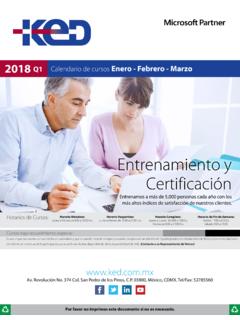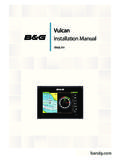Transcription of WHAT IS CONCEPTUAL UNDERSTANDING? - …
1 what IS CONCEPTUAL understanding ? CONCEPTUAL understanding is a phrase used extensively in educational literature, yet one that may not be completely understood by many K-12 teachers. A Google search of the term produces almost 15 million entries from a vast arena of subjects. Over the last twenty years, mathematics educators have often contrasted CONCEPTUAL understanding with procedural knowledge. Problem solving has also been in the mix of these two. A good starting point for us to understand CONCEPTUAL understanding is to review The Learning Principle from the NCTM Principles and Standards for School Mathematics (2000).
2 As one of the six principles put forward, this principle states: Students must learn mathematics with understanding , actively building new knowledge from experience and prior knowledge. For decades, the major emphasis in school mathematics was on procedural knowledge, or what is now referred to as procedural fluency. Rote learning was the norm, with little attention paid to understanding of mathematical concepts. Rote learning is not the answer in mathematics, especially when students do not understand the mathematics. In recent years, major efforts have been made to focus on what is necessary for students to learn mathematics, what it means for a student to be mathematically proficient.
3 The National Research Council (2001) set forth in its document Adding It Up: Helping Children Learn Mathematics a list of five strands, which includes CONCEPTUAL understanding . The strands are intertwined and include the notions suggested by NCTM. in its Learning Principle. To be mathematically proficient, a student must have: CONCEPTUAL understanding : comprehension of mathematical concepts, operations, and relations Procedural fluency: skill in carrying out procedures flexibly, accurately, efficiently, and appropriately Strategic competence: ability to formulate, represent, and solve mathematical problems Adaptive reasoning: capacity for logical thought, reflection, explanation, and justification Productive disposition.
4 Habitual inclination to see mathematics as sensible, useful, and worthwhile, coupled with a belief in diligence and one's own efficacy. As we begin to more fully develop the idea of CONCEPTUAL understanding and provide examples of its meaning, note that equilibrium must be sustained. All five strands are crucial for students to understand and use mathematics. CONCEPTUAL understanding allows a student to apply and possibly adapt some acquired mathematical ideas to new situations. Balka, Hull, and Harbin Miles 1. The National Assessment of Educational Progress (2003) delineates specifically what mathematical abilities are measured by the nationwide testing program in its document what Does the NAEP Mathematics Assessment Measure?
5 Those abilities include CONCEPTUAL understanding , procedural knowledge, and problem solving. There is a significant overlap in the definition of CONCEPTUAL understanding put forth with both the National Research Council and the NCTM definitions. Students demonstrate CONCEPTUAL understanding in mathematics when they provide evidence that they can recognize, label, and generate examples of concepts; use and interrelate models, diagrams, manipulatives, and varied representations of concepts; identify and apply principles; know and apply facts and definitions; compare, contrast, and integrate related concepts and principles.
6 Recognize, interpret, and apply the signs, symbols, and terms used to represent concepts. CONCEPTUAL understanding reflects a student's ability to reason in settings involving the careful application of concept definitions, relations, or representations of either. To assist our students in gaining CONCEPTUAL understanding of the mathematics they are learning requires a great deal of work, using our classroom resources (textbook, supplementary materials, and manipulatives) in ways for which we possibly were not trained. Here are some examples that shed light on what CONCEPTUAL understanding might involve in the classroom.
7 For grades 3 through 5, the use of zeros with place value problems is simple, but critical for understanding . " what is 20 + 70?" A student who can effectively explain the mathematics might say, "20 is 2 tens and 70 is 7 tens. So, 2 tens and 7. tens is 9 tens. 9 tens is the same as 90.". In grades 5 through 6, operations with decimals are common topics. " what is x " A student has CONCEPTUAL understanding of the mathematics when he or she can explain that cannot possibly be the correct product since one factor is greater than 6 and less than 7, while the second factor is greater than 5 and less than 6; therefore, the product must be between 30 and 42.
8 For grades 1 through 4, basic facts for all four operations are major parts of the mathematics curriculum. " what is 6 + 7?" Although we eventually want computational fluency by our students, an initial explanation might be "I know that 6 + 6 = 12; since 7 is 1 more than 6, then 6 + 7 must be 1 more than 12, or 13." Similarly, for multiplication, " what is 6 x 9?" "I know that 6 x 8 = 48. Therefore, the product 6 x 9 must be 6 more than 48, or 54.". In grade 6, fractions, decimals, and percents are integrated in problem situations. " what is 25% of 88?" Rather than multiplying.
9 25 x 88, CONCEPTUAL understanding of this problem might include "25% is the same as 1/4, and 1/4 of 88 is 22." Concepts are integrated to find the answer. In grades 4 through 6, measurement of circles is started and extended. Critical to CONCEPTUAL understanding of both perimeter and area is the understanding of . The answer to the question " what is ?" gives teachers a very good measure of student understanding . " is equal to , or 22/7" lacks student understanding . Balka, Hull, and Harbin Miles 2. " is the ratio of the circumference of a circle to its diameter, and is approximately " shows CONCEPTUAL understanding .
10 For most states, ideas about even and odd numbers are included in grades 1 and 2. Using manipulatives or making drawings to show and explain why 5 is an odd number and 8 is an even number provides evidence that a student has CONCEPTUAL understanding of the terms. "5 is an odd number because I can't make pairs with all of the cubes (squares). 8. is an even number because I can make pairs with all of the cubes? Prime and composite numbers are topics for grades 5 and 6. Manipulatives can be used by students to show CONCEPTUAL understanding of these terms. "5 is a prime number since there are only two ways to arrange squares to make a rectangle; 6 is a composite number since there are more than two ways to make a rectangle.



